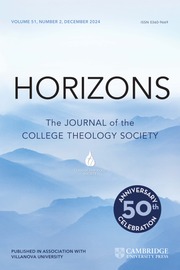The intersection between academic theology and the theology of lived experience does not occur as often as it should. In this, her fifteenth book, Wendy M. Wright makes this intersection substantive and engaging, marrying autobiographical narrative with theological reflection. As a personal exercise in “lived religion,” her reflections are more compelling than the detached cerebral forays of those merely observing the practices of others. Wright therefore demonstrates the contextuality of what it means to do theology by displaying in honest prose and vivid imagery the meaning of returning home and the intertwining of stories among pilgrims. Her pilgrimage is framed within Marian devotion specific to her native Los Angeles, as it is Mary to whom Wright attributes her interest in Catholicism and her conversion. By returning home, Wright came to see that Los Angeles, with its origins in colonial missions and ethnic diversity, represents a “microcosm of the universal Catholic church” (5) and is therefore well suited to examining the relationships between particularity and place, memory and moment.
Each chapter of the book takes as its title one of the various titles of Mary, such as “Our Lady of Refuge” or “Mystical Rose,” and nearly every page features full-color images taken by photographer Dorothy Tuma. The pictures of stained-glass windows, statues, and persons involved are gorgeously presented. Through the liberal use of images, a sense of “being there” in the parish or the garden is promoted, giving Catholic weight to the experience into which we are drawn, sacramentally ushered through the colors and textures of parish and barrio life.
The stories of those whose lives are woven with Marian images and devotion are the real focus of the book, and Wright's own story is honestly told as well, as the meaning of storytelling to understanding the divine at work in our lives becomes theological reflection. While the images and statues inspire devotion, Wright is more concerned with how devotion plays into these stories than with the iconographic history of these images, or with extensive research on the art-historical aspects of the Marian art she encounters. While she does include some background to the images provided, her fundamental concern seems to be the multidimensional effect the many identities of Mary have on the lives of those Wright meets on her pilgrimage. Wright acknowledges that some of these identities “may cause dismay” to those with post–Vatican II sensibilities (143). The oppressive and colonial facets of Catholic history more often than not became marks of victory, some of which are still acclaimed today as “evidence” that a devotional practice or belief revealed the will or activity of God.
Undergraduates would greatly benefit from Wright's parsing of devotional practice and popular religiosity. Devotions, she explains, as defined by the Vatican, have also been promoted by the Vatican; these tend to be the product of Western European traditions, such as devotion to the Miraculous Medal, the rosary, novenas, and the like. Traditions of colonized peoples, such as ceremonies of Via Crucis and Guadalupe as Mother of the Dispossessed, have often been deprecated by the official church, and so deliberately misunderstood. Robust discussion of the role of devotions and popular religious practices in Catholic life and theology would result especially from a classroom examination of chapters 12, “Lady of Victory,” and 16, “Jesus and Mary.”
Perhaps Wright could have been more critical or evaluative of such dichotomies in many of the Marian identities that have used devotion to her as a cover for the subjugation of native peoples, the irrational fear of communist infiltration, or Catholic triumphalism; I suspect that a thorough scholarly treatment of such was neither her intention in making the pilgrimage nor in writing about it. However, I hope that her efforts will inspire scholarship that does cast a critical lens on such dichotomies; as worthwhile as it is to see devotional practice as lived religion, it is also worthwhile to reflectively and reflexively examine these practices. No devotion, no tradition, no practice, no matter how deeply felt, is above inquiry.


